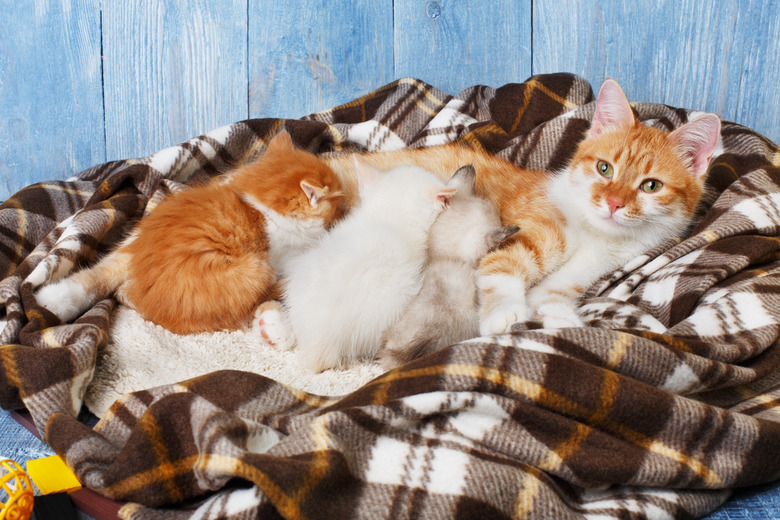Ways To Notice When Your Cat Is Close To Having Her Babies
Cats are extremely fertile creatures who can get pregnant as young as four months of age. Pregnancies typically last 63 to 67 days, and pregnant cats, or queens, give birth to one to 10 kittens. As your cat approaches her due date, there are some changes and signs for which you can watch to prepare for the new litter.
Nesting behavior in cats
Nesting behavior in cats
In the days leading up to the birth, queens will start nesting and preparing a spot to give birth. Set up a box for your cat to use for birthing. The box should be large enough for her to be comfortable with her kittens with sides that are high enough to prevent kittens from escaping but not so tall that your pregnant cat has trouble getting in and out.
Position the box in a location that is quiet, secluded, and warm. Your cat should feel safe in her nesting box, and it should be away from any drafty windows and air conditioning vents that may chill the kittens. Line the box with soft blankets. You may notice your cat arranging the blankets or bringing new towels or blankets to the nesting box.
Other physical and behavioral signs
Other physical and behavioral signs
While pregnant cats are often more affectionate during pregnancy, they may want to be alone when they are about to give birth. She may be restless and agitated, and some cats will start vocalizing in the early stages of labor. Cats may visit the litter box frequently without urinating or defecating, and they will usually lose interest in food about 24 hours before labor.
A mucousy discharge may escape from the queen's vaginal area, and her vulva may become enlarged and swollen. Body temperature is also an indicator that labor is about to begin. A normal cat temperature is between 101 and 102.5 degrees Fahrenheit. When labor is imminent, the temperature will drop to 98 to 99 degrees Fahrenheit. You can monitor this by taking the queen's temperature twice a day when you know she is nearing the end of her pregnancy.
Active labor and potential problems
Active labor and potential problems
When your cat starts active labor, hard contractions begin. You will likely be able to see the contractions in her belly, and you will be able to feel them. Once contractions start, you can expect the first kitten to be born within two hours. Most kittens are delivered about 30 minutes apart, but in some cases, there may be up to four hours between kitten births.
While contractions are normal during active labor, if a pregnant cat has back twitching, this may be a sign of a more serious problem. Eclampsia, or milk fever, is a severe calcium deficiency that usually occurs in nursing cats but may appear in the late stages of pregnancy. Muscle tremors and spasms are one symptom of the lack of calcium. Other symptoms may include depression, restlessness, drooling, or a stiff gait. This is a medical emergency, so contact your veterinarian immediately if you have any concerns.
Monitor your cat during labor for any other problems that may need veterinary attention. You should contact a vet if your cat is straining and having hard contractions for 20 minutes without birthing a kitten or if you see a kitten in the cat's vulva but the kitten is not birthed after 10 minutes of straining and contractions. Other causes for concern for your pregnant cat include fever, lethargy, depression, and bleeding from the vulva for 10 minutes or more.
References
- Forever Vets Animal Hospital: Signs a Cat is Pregnant & What To Know
- Prestige Animal Hospital: Pregnant Cat Care Tips
- Country Veterinary Clinic: What You Need To Know About the Birth of Kittens
- MedicAnimal: Understanding Common Problems During Feline Pregnancy, Queening and Lactation
- FirstVet: Understanding Cat Pregnancy and Birth

